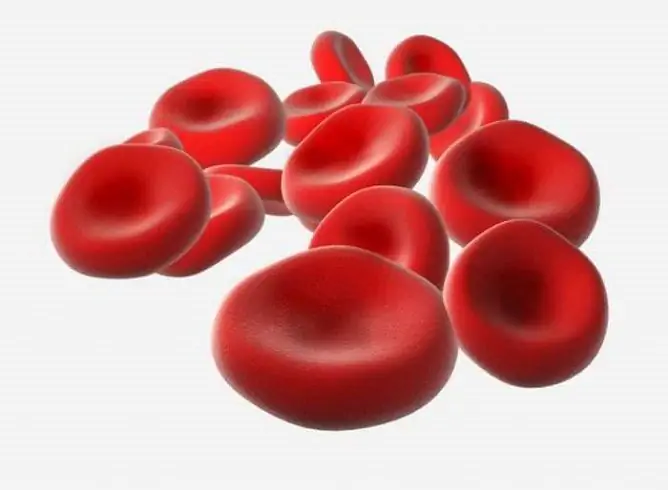MPV in a blood test - what is it?
The content of the article:
- General blood analysis
- Platelets, their types and functions
- Preparation and delivery of a general blood test
- MPV in a blood test: transcript, norms in women and men
- When the MPV in the blood test is increased and decreased
- What does MPV decrease mean?
- What to do if MPV is higher or lower than normal
MPV (abbreviated from the English mean platelet volume, mean platelet volume) is the designation of the platelet index, which characterizes the degree of maturity of platelets in the peripheral blood. The measurement is based on young cells being larger than mature and aged cells. There is a relationship between the size of platelets and their functional activity, therefore the index characterizes the state of the blood coagulation system, which platelets represent.
General blood analysis
Complete blood count (CBC, clinical blood test) is one of the most important and frequently prescribed laboratory tests. This analysis makes it possible to assess the condition of the body as a whole, to confirm or exclude the alleged diagnosis, to monitor the course of treatment.

Platelets - blood cells that stop bleeding if a blood vessel is damaged
The first general blood test is carried out for children in the hospital. As the child grows up, it is recommended to carry it out regularly during routine medical examinations, which will make it possible to timely identify abnormalities (for example, the development of iron deficiency anemia) and take the necessary measures in time. For preventive purposes, it is recommended to carry out a complete blood count for adults once, and for children twice a year.
A complete blood count includes determining the concentration of hemoglobin, the number of erythrocytes, leukocytes and platelets, the level of hematocrit, as well as erythrocyte and platelet indices and the erythrocyte sedimentation rate. A detailed blood test also includes the calculation of the leukocyte formula, which consists in determining the percentage of various types of leukocytes in the peripheral blood.
Counting the number of platelets and determining MPV is mandatory for women during pregnancy, as well as for patients with autoimmune diseases, varicose veins, liver pathologies, etc.
Platelets, their types and functions
Platelets (PLT, platelets) are blood cells with a diameter of 2-4 microns, which provide blood clotting. The functions of platelets include angiotrophic (the ability to maintain the structure and functions of the walls of microvessels), adhesive-aggregation (the formation of a primary platelet plug in damaged blood vessels), platelets are also involved in fibrinolysis, maintaining vasospasm, retraction of the blood clot. These blood cells have the ability to transport circulating immune complexes on the membrane.
There are five forms of platelets: young, mature, old, irritation and degenerative.
Platelets, like other blood cells, are formed in the bone marrow. About two thirds of the total platelet count is in the bloodstream and one third in the spleen. The precursors of platelets are megakaryocytes - giant cells with a large nucleus, from which platelets are detached. Platelets are fragments of the cytoplasm of megakaryocytes surrounded by a membrane. They do not have a nucleus, their lifespan is approximately ten days. The platelet granules contain coagulation factors, serotonin, calcium ions, adenosine diphosphate, peroxidase, platelet growth factor, von Willebrand factor, etc.
Platelets are round or oval in shape. When a blood vessel is damaged, they are activated, the cells flatten, form pseudopodia (long outgrowths) and acquire the ability to adhere to other platelets (aggregation) and the walls of the damaged vessel (adhesion). A blood clot forms, which blocks the damaged area and thereby stops the bleeding. Stimulants of platelet aggregation include serotonin, thrombin, collagen, adrenaline. In the normal (inactive) state, the platelet membrane does not support coagulation reactions. There is a relationship between the size of platelets and their functional activity, the content of biologically active substances in their granules, and the tendency to adhesion.
Normally, the number of platelets in the blood is 180-320 × 10 9 / l, varying depending on the season and time of day (daily fluctuations can reach 10%). A physiological increase in the number of platelets in the blood occurs when climbing to a height, in winter, after injury or exhausting physical activity. Physiological decrease in the number of platelets is observed before the onset and during menstruation (up to 25-50%), as well as during pregnancy.
If the balance between the formation and destruction of platelets is imbalanced, there is a tendency to thrombus formation or increased bleeding. With an increase in the number of platelets and the development of thrombosis, there is a risk of pulmonary embolism, stroke, myocardial infarction, clogging of blood vessels in other organs by clots. A decrease in platelet count leads to hemorrhage and bleeding, which can also lead to the development of life-threatening conditions.
The counting of platelets in the blood is performed using an automatic hematological analyzer, in some cases there is a need to determine the number of platelets and their size in stained blood smears under a microscope when calculating the leukocyte formula.
The platelet indices of the general blood test include:
- mean platelet volume (MPV);
- platelet distribution width by volume (PDW) - an indicator of platelet anisocytosis (depending on the prevalence of young or old forms in the blood);
- thrombocritis (PCT) - indicates the proportion of blood volume occupied by platelets (depends on the total platelet count and MPV index).

Thrombocyte indices allow you to assess the state of the blood coagulation system
Preparation and delivery of a general blood test
For the delivery of a general blood test, standard preparation rules are used. Blood sampling is carried out in the morning on an empty stomach. On the eve of the study, excessive physical and mental stress should be avoided, and fatty foods should be avoided. Do not smoke before donating blood, for half an hour before the study, the patient should be in complete rest. Blood for general analysis can be taken from both a finger and a vein.
Determination of MPV in a general blood test is carried out within two hours after the sampling of the material, since with a later study the result may be distorted.
MPV in a blood test: transcript, norms in women and men
Determination of MPV is important for assessing the hematopoietic function of the body. Using the platelet index MPV in a blood test, it is possible to reveal increased platelet aggregation, thrombosis, active blood loss (if large platelets are detected in persons with iron deficiency anemia). In addition, the MPV indicator in the blood test acts as an additional marker of chronic myeloproliferative diseases (the presence of large platelets in the peripheral blood).
The norm for MPV in adults is the same for women and men and amounts to 6-13 fl. In children under one year old, the MPV norm is 7–7.9 fl., 1–5 years old - 8–8.8 fl. For children over 5 years old, the same values are normal as for adults.
An elevated platelet MPV index indicates the presence of large platelets in the patient's peripheral blood. If the MPV in the blood test is low, this means the predominance of small platelets.
When the MPV in the blood test is increased and decreased
Increasing MPV can indicate the presence of thrombocytopenia, myeloproliferative diseases, posthemorrhagic anemia, hyperthyroidism, diabetes mellitus, infectious and inflammatory diseases, tumors, pre-eclampsia, idiopathic thrombocytopenic purpura, disorders of platelet production amid lack of vitamin B 12 or folic acid anomalies Mey - Hegglin, Bernard-Soulier syndrome. The index also rises after surgical removal of the spleen (splenectomy), in smoking patients with atherosclerotic vascular changes, with alcoholism and taking certain medications, in the elderly.
What does MPV decrease mean?
A decrease in MPV can mean an enlarged spleen (splenomegaly), the presence of cirrhosis of the liver, hypoproteinemia, kidney disease, thyroid gland pathologies. The platelet index decreases with aplastic anemia, septic thrombocytopenia, congenital megakaryocytic hypoplasia, Wiskott-Aldrich syndrome, X-linked thrombocytopenia with platelet microcytosis, thrombocytopenia due to immunological cell destruction, as well as during chemotherapy. A significant decrease in the MPV in the blood of a pregnant woman indicates a threat of miscarriage.
What to do if MPV is higher or lower than normal
When receiving MPV results in a general blood test that goes beyond the normal range, additional studies are usually prescribed: a general urine test, a biochemical blood test, a coagulogram, etc.
Treatment depends on the cause of the increase or decrease in MPV. Self-medication in this case is unacceptable, since uncontrolled intake of medications can aggravate the pathology, up to a threat to life.
In order to prevent the development of diseases affecting the blood coagulation system, it is recommended:
- regularly undergo preventive examinations;
- rationally use antiviral and other drugs (some drugs negatively affect the formation of platelets);
- eat rationally, avoid excessive consumption of animal fats, give preference to easily digestible meats (rabbit, turkey, fish);
- observe an adequate drinking regime.
You should immediately consult a doctor if you experience the following symptoms:
- discoloration of the skin and / or mucous membranes;
- unreasonable formation of hematomas;
- frequent nose and gum bleeding;
- frequent increase in blood pressure and the appearance of tachycardia;
- sharp weight loss;
- weakness, constant fatigue, deterioration of the general condition for no apparent reason and for a long time, which do not pass after a good rest.
YouTube video related to the article:

Anna Aksenova Medical journalist About the author
Education: 2004-2007 "First Kiev Medical College" specialty "Laboratory Diagnostics".
Found a mistake in the text? Select it and press Ctrl + Enter.







